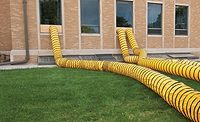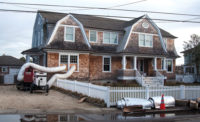The year 2013 saw many research projects conducted at HSG CodeBlue’s Structural Drying Laboratory in Springfield, Ohio. Potential faster drying times and the ability to salvage materials, once thought to be beyond recovery, underline the importance of research aimed at strengthening capacity to cope with drying flooded structures. One such study conducted occurred in November 2013 and involved drying a flood house with ΩDBK’s Drymatic system.
While it is well established to professional restorers that heat energy dries materials faster, assessing the benefit cannot be done without a clear understanding of the methods and tools available. Heat drying technology is advancing and challenging the ways our industry dries structures. Faster drying times ensures that flood victims can return to their normal lifestyles sooner.
The possibility that faster drying times could be achieved were proven last year when ETES units were studied at the laboratory. Reports from both this study and from building science, water damage restoration standards show the connection between faster drying times and heat energy. Heat drying is something of a catch-all term, referring to drying with temperatures of varying magnitude using different delivery systems and equipment.
To demonstrate the drying capability of the system, the structure was first flooded. On Sunday evening, November 17th, the structure (e.g., drywall, subfloors, hardwood, tile, carpeting, cabinets, contents, etc.) was saturated with ~1500 gallons of water using a ¾ inch garden hose, as performed in previous studies. Monday morning the house was flooded again from 4 a.m. to 8 a.m. Monday afternoon, approximately 16 hours after flooding the structure, carpet was extracted using four passes with an extractor. Three rooms were involved in the study, kitchen, dining and living room. Moisture content readings were collected and psychrometric readings were collected using a thermo hygrometer.
Following extraction, the heat drying unit was set up to dry the kitchen, dining and living rooms. The processed air from the system was further enhanced by two boost boxes connected to their mat system covering the hardwood floor in the kitchen. The mats accelerate diffusion to help expedite evaporation. The two boost boxes, with air movers attached, provided distribution of ambient air heated to oak hardwood and fir subfloor. The boxes provided temperature increases in the drying chamber with an average of 24.30 F.
Two additional boost boxes with air movers were set up to dry the carpeted living room. The carpet was disengaged from the tack strip and the units inserted under the carpet to dry the subfloor and textile.
The ambient temperature at 1 p.m. on November 18 was 81.50 F and 74.3% RH in the affected chamber, or 121 gpp. The ambient temperature increased to a high of 1090 F and 22.7% RH, or 85 gpp. The structural material reached dry goals within 48 hours. The outside temperature ranged from a low of 390 F to a high of 72.50 F during the study with relative humidity ranging from a high of 77.5% to a low of 17.3%. Outside air was used as make up air when the unit exhausted moisture laden air to the outside. Intake air was ducted into the unit through a flex duct inserted through the dining room window. Exhaust air was processed through the unit and exhausted through flex duct on the opposite side of the flood house through a window in the living room. Within limits defined by the user, the unitwill monitor and adjust the room’s environment, constantly optimizing and exchanging the moist air with warm, dry air in a controlled manner to ensure a faster, more efficient drying environment. No dehumidification was used in the drying chamber. One observation worth noting was cupping on the interior section of the kitchen hardwood measuring approximately 50 square feet. A mat system, which was not used during the two-day drying process, was set up in the cupped area that corrected the abnormality within 2 hours. The cause was trapped moisture between the hardwood and the fir and the mat system was able to effectively use the warm dry air created by the intelligent heat drying system employed to dry underneath the boards.
It is generally accepted that employing direct-heat application increases the temperature of wet materials and expedites drying times. This was confirmed during the study with materials reaching temperatures of up to 1250 F reducing drying times from an average of 4.5 days to 2 days. Few studies have actually measured the time reductions when heat is employed in drying flooded structures. Shorter drying times provide savings to carriers and allow flood victims to return their normal lifestyle quicker.
In addition to the data mentioned above, this experimental set-up was equipped with a variety of sensors, including intake and exhaust temperatures and relative humidity levels, which provided data showing that relative humidity in the drying chamber was reduced from 63% to below 30% in less than 24 hours.
Implications from the study indicate that intelligent control of energy is crucial in ensuring drying goals are achieved while minimizing drying time and saving valuable materials. While direct-heat energy has been used for decades, the new technology available today can be employed to establish science-based drying systems that monitor surface and air temperatures while simultaneously determining moisture content and adjusting heat by increasing or decreasing energy as required. This technology can be employed with or without refrigerant or desiccant drying technology.
Since drying increases as a function of a material’s permeance or porosity, particular attention was paid to the length of drying time of various materials. Porous materials, such as carpet, dried in as little as 24 hours while subfloors and hardwood required up to 48 hours. The living room carpet dried within 24 hours with the exception of one area where the sofa restricted air flow. Once the sofa was moved, the area beneath it dried quickly as was the case with small isolated wall areas and isolated pockets of subfloor. Repositioning equipment for short intervals (
To conclude, the observations indicate that direct-heat drying technology provides shorter drying times than refrigerant or desiccant technology.








Report Abusive Comment